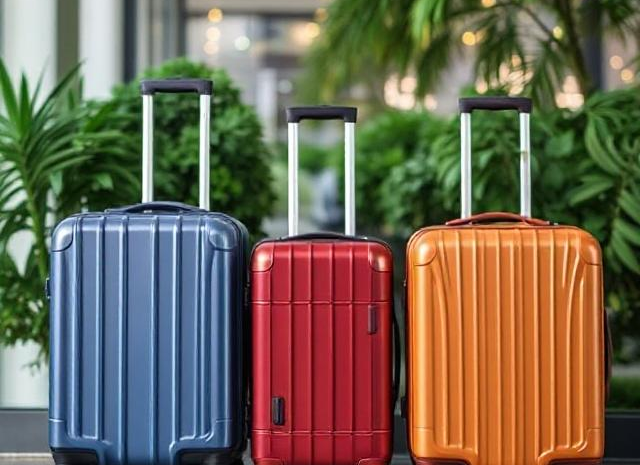
How To Choose The Best Luggage For Your Travel Needs
Choosing the best luggage for your travel needs can make a huge difference in your travel experience, whether you’re going on a weekend getaway or an extended international trip. Here are some key factors to consider when selecting the perfect luggage for your journey:
1. Consider the Type of Travel:
- Short Trips (Weekend Getaways or Business Travel): If you’re just going for a short trip, you might want a carry-on suitcase or weekender bag. These are typically compact, easy to carry, and don’t require checking in.
- Longer Trips (International or Extended Stays): For longer trips, you’ll likely need a larger suitcase or checked luggage. Choose one that offers ample packing space, and ensure it’s durable for multiple long-haul flights or road trips.
- Adventure or Outdoor Travel: If you’re going on an adventure trip, such as hiking, camping, or to remote locations, consider a duffel bag, backpack, or a soft-sided suitcase with durable, water-resistant fabric.
2. Size and Capacity:
- Carry-On Luggage: The standard carry-on size is generally 22″ x 14″ x 9″ (56 x 36 x 23 cm), though this can vary slightly between airlines. Carry-on bags are great for short trips or as an additional bag on longer trips. Keep in mind the weight restrictions as well.
- Checked Luggage: Checked luggage typically ranges from 24″ to 30″ in height. This size allows for more packing space but means you’ll need to check the bag at the airport. Larger bags may be more cumbersome, but they offer plenty of room for packing clothes, shoes, and souvenirs.
- Expandable Luggage: Some suitcases come with an expandable feature, which can be useful if you need extra room for souvenirs or unexpected items. However, keep in mind that expanding the luggage can cause it to exceed carry-on or checked baggage size limits.
3. Material:
- Hard-Shell Luggage: Hard-shell suitcases made of materials like polycarbonate, ABS plastic, or aluminum offer good protection for fragile items, such as electronics or glass. They’re often lightweight, durable, and sleek in appearance. However, they can be prone to scratches.
- Soft-Sided Luggage: Soft-sided luggage, typically made of nylon or polyester, tends to be more flexible, allowing you to squeeze it into tight spaces. It’s often lighter than hard-shell bags and can be expanded for extra room. However, it may offer less protection against rough handling.
- Hybrid Luggage: Some modern suitcases are a combination of both soft and hard materials, providing the benefits of flexibility with added protection.
4. Weight:
Luggage weight is crucial because airlines have strict weight limits for both carry-ons and checked luggage. Lightweight luggage can save you from paying extra baggage fees and make it easier to maneuver your bag.
- Lightweight Materials: Look for suitcases made of lightweight materials like polycarbonate for hard-shell cases, or high-density nylon for soft-sided bags. Be mindful of the overall weight even without packing anything inside.
- Avoid Overpacking: Lightweight luggage makes it easier to stick to weight limits. When choosing a bag, always consider both the weight of the bag itself and your packing needs.
5. Wheels and Maneuverability:
- 2-Wheeled Luggage: Traditional luggage with two wheels is pulled behind you. While it may be easier to roll on flat surfaces, it can be cumbersome on uneven terrain.
- 4-Wheeled Spinner Luggage: Spinner luggage has four wheels that rotate 360 degrees, allowing you to roll the bag beside you, which is much easier to maneuver in crowded areas or on uneven surfaces. These tend to be more expensive but can make travel much smoother.
- Durability: Make sure the wheels are sturdy and well-constructed, as damaged wheels can severely affect the usability of the luggage.
6. Security Features:
- Locks: Many luggage options come with built-in locks, and some are equipped with TSA-approved locks. These locks allow TSA officers to inspect your bag without damaging the lock, adding an extra layer of security.
- Zipper Quality: High-quality zippers are essential for preventing theft or accidental openings. Look for luggage with lockable zippers or those that use rugged zipper tracks for extra durability.
7. Interior Organization:
- Compartments and Pockets: Choose luggage that helps you stay organized. Look for suitcases with multiple compartments, mesh pockets, or dividers to separate your clothing, shoes, toiletries, and tech gadgets.
- Compression Straps: Compression straps help keep clothes packed tightly and prevent them from shifting around. This is particularly helpful for soft-sided luggage or if you need to make the most of your packing space.
8. Durability and Warranty:
Luggage that is durable and can withstand rough handling is important for frequent travelers. Consider luggage with strong frames, sturdy wheels, and solid zippers. Many brands offer warranties on their luggage, which is worth considering for long-term value.
- Brand Reputation: Established luggage brands often offer better durability and longer warranties. Popular brands like Samsonite, Away, Tumi, and Briggs & Riley are known for making high-quality luggage.
9. Budget:
- Entry-Level: If you’re a casual traveler, you might want to start with a budget-friendly option. You can find quality carry-ons and checked luggage at affordable prices from brands like American Tourister or Rockland.
- Mid-Range: If you’re a frequent traveler, investing in mid-range luggage brands such as Samsonite or Travelpro might be the right balance between price and durability.
- Premium: For those who travel often and want high-end, durable luggage with added features, premium brands like Tumi or Rimowa offer top-tier products, but at a higher price.
10. Style and Design:
While functionality should be the top priority, the look of your luggage can also matter. Opt for a color or design that stands out at baggage claim but is still sophisticated enough for your needs. Bright colors or unique patterns can make your bag easier to spot.

